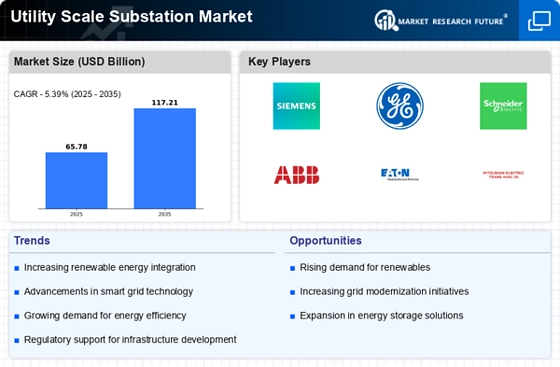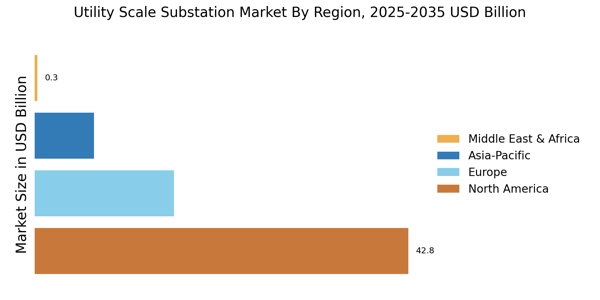Rising Demand for Electricity
The rising demand for electricity is a fundamental driver influencing the Utility Scale Substation Market. With urbanization and industrialization on the rise, the global electricity consumption is expected to increase significantly. According to recent estimates, global electricity demand could grow by over 25% by 2030. This surge necessitates the expansion and modernization of electrical infrastructure, including utility scale substations, to ensure reliable power delivery. As utilities strive to meet this growing demand, investments in substation upgrades and new installations are likely to escalate. This trend not only supports the existing grid but also facilitates the integration of renewable energy sources, further propelling the market forward.
Increased Focus on Grid Resilience
Increased focus on grid resilience is emerging as a vital driver for the Utility Scale Substation Market. As extreme weather events and natural disasters become more frequent, the need for a robust and resilient electrical grid is paramount. Utilities are investing in infrastructure improvements to enhance the reliability and resilience of their systems. This includes upgrading existing substations and constructing new ones designed to withstand adverse conditions. The market for resilient grid technologies is projected to grow significantly, with investments expected to reach approximately 30 billion USD by 2026. This emphasis on resilience not only ensures continuous power supply during emergencies but also supports the overall stability of the energy network, thereby driving demand for utility scale substations.
Government Initiatives and Incentives
Government initiatives and incentives play a crucial role in shaping the Utility Scale Substation Market. Many governments are implementing policies aimed at promoting renewable energy and enhancing grid infrastructure. These initiatives often include financial incentives, tax breaks, and grants for the development of utility scale substations. For instance, various countries have set ambitious renewable energy targets, which necessitate the expansion of substations to accommodate new energy sources. In 2025, it is estimated that government funding for energy infrastructure projects could exceed 50 billion USD, highlighting the significant financial commitment to this sector. Such support not only stimulates market growth but also encourages private sector investment in utility scale substations.
Integration of Energy Storage Solutions
The integration of energy storage solutions is a pivotal driver for the Utility Scale Substation Market. As the demand for renewable energy sources increases, the need for efficient energy storage systems becomes apparent. Energy storage technologies, such as batteries, allow for the stabilization of power supply, ensuring that energy generated from renewable sources can be effectively utilized. In 2025, the energy storage market is projected to reach a value of approximately 20 billion USD, indicating a robust growth trajectory. This integration not only enhances grid reliability but also supports the transition towards a more sustainable energy landscape. Consequently, utility scale substations are increasingly being designed to accommodate these storage solutions, thereby driving market growth.
Technological Advancements in Substation Design
Technological advancements in substation design are reshaping the Utility Scale Substation Market. Innovations such as digital substations, which utilize advanced sensors and automation technologies, enhance operational efficiency and reliability. These modern designs allow for real-time monitoring and control, reducing maintenance costs and improving response times to outages. The market for digital substations is anticipated to grow at a compound annual growth rate of over 10% through 2025. Furthermore, the adoption of modular substation designs enables quicker deployment and scalability, catering to the evolving energy landscape. As utilities increasingly prioritize efficiency and reliability, these technological advancements are likely to drive substantial growth in the utility scale substation sector.


















Leave a Comment